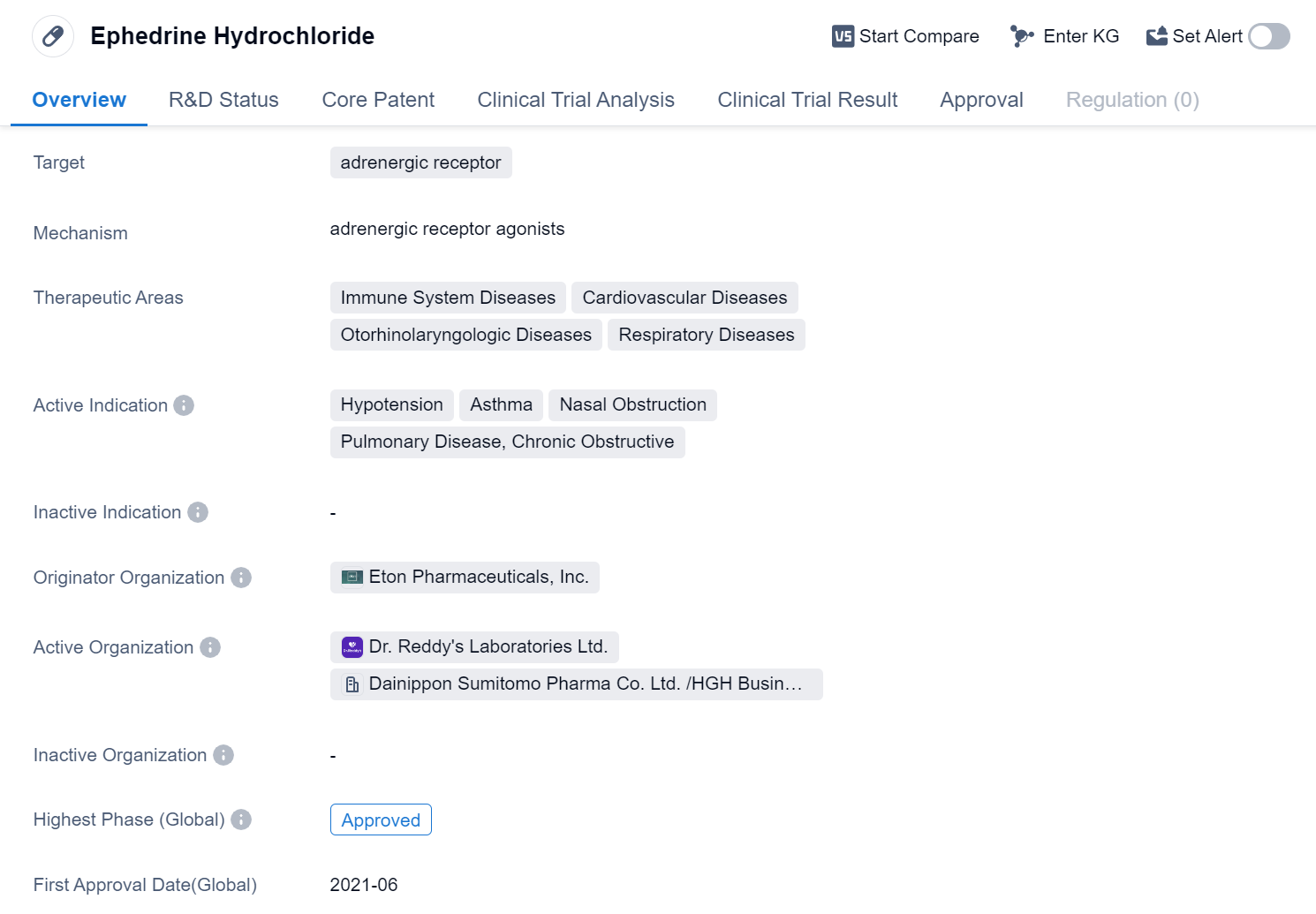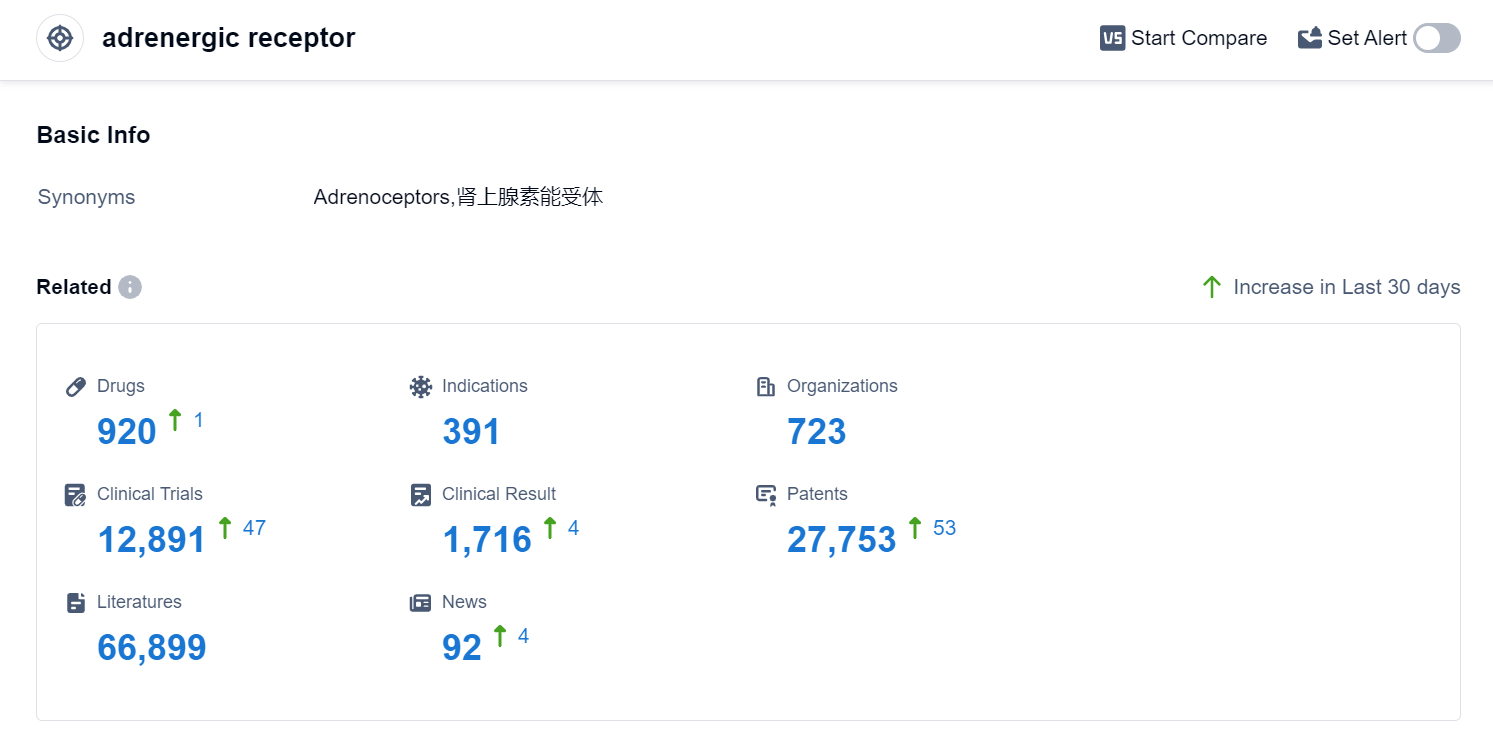Unleashing the Power of Ephedrine Hydrochloride: A Comprehensive Review on R&D Breakthroughs
Ephedrine Hydrochloride's R&D Progress
Ephedrine Hydrochloride is a small molecule drug that targets the adrenergic receptor. It has been approved for use in the treatment of various conditions related to the immune system, cardiovascular system, otorhinolaryngologic system, and respiratory system. The drug has shown efficacy in treating hypotension, asthma, nasal obstruction, and chronic obstructive pulmonary disease.
The originator organization of Ephedrine Hydrochloride is Eton Pharmaceuticals, Inc. This pharmaceutical company has successfully developed and obtained approvals for the drug in the global market. The highest phase of development for Ephedrine Hydrochloride is approved.
The first approval of Ephedrine Hydrochloride was granted in June 2021 in the United States. This signifies that the drug has met the regulatory requirements set by the U.S. Food and Drug Administration (FDA) for its specific indications. The approval in the United States suggests that Ephedrine Hydrochloride has undergone extensive clinical trials and has demonstrated positive results in treating the targeted diseases.
Ephedrine Hydrochloride's therapeutic areas cover a wide range of medical conditions, including immune system diseases, cardiovascular diseases, otorhinolaryngologic diseases, and respiratory diseases.
As a small molecule drug, Ephedrine Hydrochloride is likely to have a well-defined chemical structure and mechanism of action. This characteristic makes it suitable for formulation and manufacturing processes, ensuring consistent quality and reproducibility.
👇Please click on the image below to directly access the latest data (R&D Status | Core Patent | Clinical Trial | Approval status in Global countries) of this drug.
Mechanism of Action for Ephedrine Hydrochloride: Adrenergic receptor agonists
Adrenergic receptor agonists are a class of drugs that bind to and activate adrenergic receptors in the body. Adrenergic receptors are a type of receptor found on the surface of cells, particularly in the nervous system and other tissues. These receptors are specifically responsive to the neurotransmitters called catecholamines, such as adrenaline and noradrenaline.
When adrenergic receptor agonists bind to these receptors, they mimic the effects of catecholamines and stimulate various physiological responses in the body. This activation can lead to increased heart rate, elevated blood pressure, bronchodilation, and constriction of blood vessels in certain areas.
In a biomedical perspective, adrenergic receptor agonists are commonly used in the treatment of conditions such as asthma, hypertension (high blood pressure), and certain cardiovascular disorders. By activating adrenergic receptors, these drugs can help relax and open up airways, increase cardiac output, and regulate blood pressure.
It is important to note that adrenergic receptor agonists can have different selectivity for specific subtypes of adrenergic receptors, such as alpha or beta receptors. This selectivity determines the specific physiological effects produced by the drug. Additionally, the dosage and duration of treatment with adrenergic receptor agonists should be carefully monitored and adjusted by healthcare professionals to avoid potential side effects and ensure optimal therapeutic outcomes.
Drug Target R&D Trends for Ephedrine Hydrochloride
According to Patsnap Synapse, as of 10 Sep 2023, there are a total of 920 adrenergic receptor drugs worldwide, from 723 organizations, covering 391 indications, and conducting 12891 clinical trials.
The analysis of the target adrenergic receptor reveals a competitive landscape with multiple companies actively involved in research and development. Novartis AG, GSK Plc, AstraZeneca PLC, Pfizer Inc., and Sanofi are the leading companies with a strong presence in different phases of development. Drugs targeting the adrenergic receptor have been approved for various indications, including hypertension, asthma, common cold, and pulmonary diseases. Small molecule drugs dominate the drug types, indicating intense competition and ongoing research. China, the United States, and Japan are the leading countries in terms of drug development, with significant contributions from other countries as well. The target adrenergic receptor presents a promising area for future development and therapeutic interventions in various diseases.
👇Please click on the picture link below for free registration or log in directly if you have a freemium account, you can browse the latest research progress on drugs, indications, organizations, clinical trials, clinical results, and drug patents related to this target
Conclusion
In summary, Ephedrine Hydrochloride is a small molecule drug developed by Eton Pharmaceuticals, Inc. It has been approved for use in the treatment of immune system diseases, cardiovascular diseases, otorhinolaryngologic diseases, and respiratory diseases. The drug targets the adrenergic receptor and has shown efficacy in treating hypotension, asthma, nasal obstruction, and chronic obstructive pulmonary disease. Its first approval was granted in the United States in June 2021, indicating its compliance with regulatory standards.






